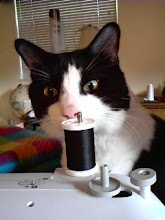The recreational sewer will walk in and browse through the fabric. She usually goes for the pretty fabrics, whether she knows how to use them or not. She has enough experience to be somewhat confident, though, and enough money to completely scrap a failed project and buy or make a replacement.
The veterans and the professionals know the layout of the store. They march right up to the section they're looking for. They don't browse on purpose because they know they will buy something they don't need, and already have a huge stash at home. While waiting in line they will hand out extra coupons and answer other customer's questions. (They'll also sometimes loudly voice their opinions about products or techniques, whether we want to hear them or not.)
But the Newbies shuffle down the hall with wide eyes. They stand in the checkout line with full bolts of fabric. They buy lots of ribbon. They scold us for not selling every button ever made, because they can't match the one on their great-aunt Mildred's moth-eaten sweater.
They usually only want to attempt one of two things: a small home project, like drapes or a baby blanket, or they mistakenly believe it would be cheaper to recover a couch than to buy a new one. (A brand new couch costs $600-$1000. For a reupholstered old couch, the cost of fabric alone is $400-$1000 [10 yards at $40/yd], plus labor, and a pro might charge $500-$800 to do it. And Oh my God I don't care about where you got it or how much of a deal it was!!!!!)
They ask pretty standard questions: Can I use this fabric to make this? Would a yard be enough to make this?
But the question that most shows off your green is: "What kind of thread should I use to sew this?"
Of course naturally the novice seamstress is going to think of thread before she thinks of a needle. The sewing machine she found in the attic already has a needle! Why would she need another one?
Thread is important, yes. It bonds the fabric together. But after its stitched it just kinda lays there. Think of thread as glue. When you buy glue, do you buy the bottle with the spiffy little applicator tip? Or do you buy a bucket of it and smear it on with your hands?
There are a myriad of different types of needles out there. But the new sewer should only worry about the basics, the size of the needle, and the point of the needle.
The most commonly used needle size is 90/14. (14 is American and 90 is European. We can never agree on numbers.) This size is used for light to medium weight fabrics, like plain cotton and t-shirt material. It's always good to have an extra pack of these laying around.
In sewing, the smaller the number, the smaller the needle. Lightweight fabrics, like chiffon, charmeuse, or any fabric you can clearly see through, needs a lightweight needle. Needle sizes start at 60/8, but anything smaller than a 90/14 should work fine. Use your best judgment. Using a needle that is too big can leave holes in the fabric, or even worse tear the actual strands and cause the fabric to slowly unravel.
However, fabrics with a very open weave, like netting or cheesecloth, can "choke" your sewing machine by getting tangled in the bobbin mechanism. I suggest sewing these guys by hand unless you really know what you're doing.
When it comes to thicker fabrics, like denim and canvas, it's better to use a thicker needle. A 100/16 is thick enough to work with a thin denim or twill, but I usually tell customers to just grab the pack of needles that say "DENIM JEANS" at the top. Thicker fabric is less susceptible to holes and damage, but using too small of a needle can cause the needle to break, and if you make that needle mad, it's gonna come after you. Some particularly cautious people even say to use protective eyewear when sewing. At the counter, I once heard a story about how one lady's needle snapped while she was trying to sew through four layers of denim (not advised, btw). One piece of it flew up and lodged itself in her tearduct and she spent the night in the emergency room with a needle sticking out of her eye.
Another way to avoid these problems is to get the right point on your needle. There are three main points you should know, sharp, ball point, and universal.
Sharps are, well, sharp, and are good for woven fabrics. I think they're best for quilting, but I don't quilt.
Ball-points are best for knits and stretch fabrics. Sharper needles can tear the yarns in the knit, causing it to "ladder."Knits don't generally fray, so when a yarn breaks and starts to wriggle out of place, it leaves a run that kinda looks like a ladder. A ball-point needle has a rounded point so it pushes the yarns aside and leaves them unharmed.
All-purpose thread is called that for a reason; you can use it to make pretty much anything. In fact, the only time I would say to use a different thread is if you're doing upholstery or something that is going to go outside. (Normal thread will decay faster when exposed to the elements. Go with a heavy polyester or nylon.)
Sewing takes a lot of common sense. Before you panic, just try to reason. Crafters have to be smart in order to make what they make. There's a lot of subconscious ticking going on in your dome. Take a second to listen to it. It might be easier than you think.
Helpful websites are out there too! I looked up this one in particular to make sure I had all my facts straight: http://sewing.about.com/od/sewingmachineindex/ig/Sewing-Machine-Needles/

